Abstract
Ritual knots are symmetrical crisscrossing designs that appear in distant cultures around the world. Their independent emergence is plausibly due to shared features of human cognition and experience that such patterns represent. Since empirical investigation of this possibility is lacking in the literature, our aim is to open up this research area. We do so by asking whether the cultural production and appreciation of ritual knots could be conditioned or motivated by alignments and affordances linked to creative human cognition—advanced analogical modeling processes that are themselves often discussed in terms of bidirectional blending and symmetrical mapping. If manual tracing of a traditional knot design had positive priming effects on such reasoning processes, as we hypothesize, this would suggest an explanatory link between the two. To begin testing this hypothesis, we selected a basic, traditional knot design from Tibet, along with three established measures of formal analogical reasoning and one original measure of syntactic preference involving reciprocal constructions. We then undertook a series of cognitive trials testing for potential cognitive benefits of manually tracing the design. We contrasted prime condition results with a control group and an anti-prime condition group. The data show observable effects of time across multiple measures but no significant effects of time or condition, controlling for reported mindfulness. While this rules out the short-term priming effects of enhanced analogical reasoning at the analytic level following brief manual tracing of this design, the research opens the way for further empirical experimentation on the nature and emergence of symmetrical knots and their potential relationships with patterns of human thought.
1. Introduction
Celtic knot designs from medieval Ireland share striking resemblances with traditional patterns maintained half a world away—such as the ritual sand tracings of Vanuatu islanders in the South Pacific and the “endless knots” of Tibetan Buddhism. Interlacing design symmetries such as these have emerged independently around the world and have persisted across millennia, in spite of their absence in the natural world. This poses something of a riddle or “cognitive challenge” [1] to anthropology and should be seen as a promising topic for research across the cognitive sciences. However, few studies have looked into the origins and nature of these designs, and potential links with human cognition are seldom considered; cf. [2,3]. In fact, the most widely discussed hypotheses to date for the emergence and cultural transmission of ritual knot patterns across cultures tend to reduce their production to alienating experiences, such as trance-induced states initiated by some combination of social crisis, physiological trauma, ritual ceremony, and/or the use of narcotics [4,5,6,7]. Researchers approaching the problem from these perspectives argue that geometric entoptic manifestations that are sometimes noted to occur under such conditions provide a plausible explanation for their independent appearance and maintenance in distantly separated cultures. We admit that such explanations may be partially explanatory but also find them to be ultimately unsatisfactory, since they tacitly exclude the uptake and propagation of such patterns among broader populations and inhibit exploration of more meaning-centered explanations binding the social to the psychological, the person to the external manifestation.
Another hypothesis proposed for the common source of these patterns suggests that they might originate in shared features of human thought [2,3,8]. Ritual knot designs are arguably built on more rudimentary diagonal cross-hatching designs that show up in the archaeological record as early as the middle Paleolithic [9,10]. A recent cognitive study of these more rudimentary designs, found that increasingly refined diagonally symmetrical patterns must have “evolved to become more effective ‘tools for the mind’ as their producers became more skilled symbol makers” [3]. The development of these cognitive tools would plausibly have been enhanced further as diagonal crosshatching designs were modified to loop back into the pattern, creating an integrated whole through interlacing lines. Anthropologists researching ritual knots and symmetrical sand-drawings in Vanuatu, for instance, suggest strong relationships between these designs and various cultural patterns, ranging from the sociohistorical to the sociopolitical [11,12].
In fact, uniquely human thought processes involving creative, analogical pattern solving are often discussed in terms that evoke interlacing symmetries. Discussions of symmetrical reasoning and bidirectional inference in human thought and language acquisition bear this out [2,13,14,15,16,17], as do observations of chiastic patterning in culture and thought [7,18,19,20,21] and discussions that posit “conceptual blending” as the core of human cognition [22,23]. Indeed, theoretical descriptions such as these are grounded in abstract patterns that share many basic similarities with ritual knot designs.
Symmetrical biases in everyday reasoning, for example, are species-specific human traits that hinge on the convenience or usefulness of AB:BA analogies in spite of their illogical status [13]. If I know that the ground gets wet after it rains (AB) and thereby conclude that it must be raining upon looking out and seeing that the ground is wet (BA), this would be, strictly speaking, a logical fallacy. However, the analogy in question will often be true nonetheless; so it might very well pay off for me to grab my umbrella on the way out the door. This kind of bidirectional reasoning functions as a kind of cognitive shortcut. These shortcuts are pervasive in human cognition, and they are crucial for the production of creative analogies or conceptual blends [17,22]. These bi-directional or symmetrical reasoning processes can be identified everywhere from lexical/conceptual and syntactic levels to pragmatic and systems-oriented levels of myth and worldview [13,17,19,20,23].
With these connections in mind, it is plausible to hypothesize that the production and reproduction of intertwining design symmetries manifest in ritual knot patterns could be related to analogous patterns of human thought in ways that are non-trivial. Could the production and reproduction of ritual knot designs have cognitive affordances that enhance creative, analogical pattern solving? This is a basic question that has remained unresearched. The only study we have found that deals with the effects of manual knot tracing is a report on the development and deployment of haptic feedback in a computer mouse interface to explore and better understand the shapes of mathematical knots for the enrichment of knot theory [24]. Precedents that are somewhat closer to our approach can be found in Jungian psychotherapy. Some researchers have carried out empirical studies on links between therapeutic benefits, such as anxiety reduction, and the creation and coloring of mandala patterns [25,26,27,28,29,30]. However, neither of these lines of inquiry are directly concerned with symmetrical knot designs, nor are they focused on hypotheses related to potential links with congruent thought patterns. To begin exploring these potential relationships, we designed and carried the series of cognitive trials reported in this paper.
Our primary aim in carrying out this study is to open up a new area of research, exploring the potential cognitive alignments and affordances of the perception, creation, and reproduction of symmetrical knot designs. In doing so, we begin to address a substantial gap in the literature. Although the results of our initial experiments suggest that analytic modes of analogy should be ruled out as a short-term cognitive priming motivation for manual reproduction of ritual knots (or at least of the knot we selected for manual reproduction), this research is only intended as an initial step. Overall, the experiments we report on in this paper open the way for new, ongoing research into the nature of ritual knots and related patterns, prominently including their potential links with patterns of human thought.
2. Study 1
We opted to study manual tracing of a basic traditional knot design from Tibet as a potential priming factor for enhanced performance on creative, analytic processes of analogic reasoning. We designed an empirical lab-based experiment to test two primary hypotheses: (1) that repeated tracing of a symmetrical knot design would correlate with enhanced performance on creative cognitive tasks involving formal analogical reasoning; and (2) that these effects would be more apparent when traced mindfully.
2.1. Materials and Methods
2.1.1. Participants
In total, 280 Ryerson University undergraduate students were recruited from two classes offered during the fall 2017 semester and winter 2018 semester. Students were compensated 5% of their total course mark for participating in the study, and students who wished to opt out of the lab study were given the option to complete an alternative assignment worth an equivalent amount.
Of the 280 participants, 57 were part of an initial pilot study undertaken in order to ensure all study components were functioning smoothly. Of the remaining 223 participants, 19 were excluded from the prime and anti-prime conditions for skipping tracing between measures in one or more rounds; 2 were excluded for self-reporting that they were not following instructions carefully; and 1 was excluded for reporting familiarity with two of the four materials. Moreover, 3 participants were excluded for alternating hands while tracing; 2 were excluded for restarting the tracing module after completion instead of advancing to the next measure as instructed; and 8 others were excluded for similar anomalies (including neglecting to wait for tracing instructions, lifting finger multiple times from screen instead of tracing in a single continuous line, scribbling across the pattern instead of following the contour of the design as instructed, stopping and starting the tracing instead of tracing continuously, closing their eyes during tracing, tracing the pattern only once instead of tracing continuously until time was up, and being unable to make contact with the touchscreen due to the length of augmented fingernails). Finally, 11 participants were excluded due to Qualtrics errors that prevented pages from loading.
Of the 177 remaining participants, 136 (76.8%) identified as female, 39 (22%) identified as male, and 2 (1.1%) identified as other. Participants were between the ages of 17–37 (M = 19.2, SD = 2.23). Students were randomly assigned to conditions using an online randomizer (Prime = 51, Anti-Prime = 75, Control = 51).
The studies reported here were approved by the Ryerson University Research Ethics Board (REB 2017-065). All participants provided written consent prior to participation and were reminded both in the written consent form and verbally before beginning the study that they were free to withdraw consent and terminate participation at any time for any reason. Participants were informed that all data would be processed and disseminated anonymously. The 5% course mark compensation was approved by the REB due to the relevance of the study for theory and methodology instruction in the following undergraduate courses: LIR100 Global Models in Intercultural Relations, ANT100 Introduction to Anthropology, and ACS100 Introduction to Language. The alternative assignment consisted of an extra assigned reading accompanied by a list of content questions to prompt demonstration of reading comprehension. Selected readings were related to embodied cognition and language instruction (for LIR100 and ACS100 students) or cognitive anthropology (for ANT100 students).
2.1.2. Demographic Questionnaire
Participants were asked to self-report their age and gender, as well as answer questions regarding their language proficiency and child-language acquisition, whether they were born in Canada, how long they have lived in Canada, and if they had ever lived outside of Canada. The full demographic questionnaire is reproduced in Document S2 in the Supplementary Materials.
2.1.3. Remote Associates Test (RAT)
The Remote Associates Test (RAT) [31] is a standard measure of creativity relying on typical lexical associations. We included this test as a partial measure of our primary hypothesis introduced above. The advantage of this measure is its ability to test formal analogical reasoning by creative association vs. logical, recursive relations—the latter being tested in the VAT and AFT, as discussed below. We administered the RAT in two sets of eight problems each. In each set, of eight, participants were presented with three seemingly unrelated words and were asked to provide a fourth word that could be associated with all three. Participants were given a blank space to type in their responses to each word trio. An example problem given to participants for illustration was the word set “elephant, lapse, and vivid,” with the correct response word in this case being “memory.” Eight of the word pairings were presented in the pre-test, and the remaining eight were presented in the post-test. Scoring in each phase was calculated out of eight potentially correct responses.
2.1.4. Verbal Analogies Test (VAT)
The Verbal Analogies Test (VAT) [32] is a measure that assesses an individual’s basic analogical reasoning. We included this test as a partial measure of our primary hypothesis introduced above. The advantage of this measure is its ability to test formal analogical reasoning by established, conventional association of logical, recursive relations. The VAT was divided into two six-question sections, with the first section presented in the pre-test, and the second section presented in the post-test. Participants were presented with incomplete analogies and asked to fill in the blanks. The example analogy provided was “______ is to PUPPY as CAT is to ______”. In this way, participants are asked to consider and generate analogies in a manner that they may not be accustomed to as the blanks are inverted in each part of the analogy. Participants were presented with a blank space onscreen to type in their answers for each question. Participant scores on this measure represented the percentage of correct responses.
2.1.5. Reciprocal Syntax Test (RST)
The Reciprocal Syntax Test (RST) was developed by the corresponding author in order to assess an individual’s preferred mode of reciprocal syntax, including chiastic syntax (featuring A : B :: B′ : A′ patterning) and three other reciprocal constructions. We included this test as a partial measure of our primary hypothesis introduced above. The advantage of this measure is its ability to test for analogical reasoning at the level of grammatical patterning. For each item tested, participants were presented with an image, along with four possible descriptions of the image in a multiple choice format and were instructed to select their answers based on personal preference. For example, an image of a bee on a flower was presented to participants, accompanied by the following four statements: (1) “The bee is pollinating the flower in exchange for nectar”; (2) “The flower gives nectar to the bee while the bee pollinates the flower”; (3) “The bee and the flower are exchanging nectar and pollination with each other”; (4) “The flower is providing nectar for the bee in exchange for pollination”. Item presentation order and sentence ordering for each item were randomized in Qualtrics. Four test items were presented in the pre-test, and four were presented in the post-test. Further detail on this measure is provided in Document S1 in the Supplementary Materials.
2.1.6. Analogy Finding Task (AFT)
The Analogy Finding Task (AFT) [33,34] is a measure designed to assess creative analogical reasoning. We included this test as a partial measure of our primary hypothesis introduced above. The advantage of this measure is its ability to test formal analogical reasoning by unconventional associations involving logical, recursive relations. The AFT includes two sets of 5 partial analogies with 20 possible word pairings to complete the analogy. For each partial analogy, there is one within-domain word pair and two or three cross-domain pairings that create a total of 3 or 4 valid analogies. Semantic distance computation and rationale are discussed in the original study by Weinberger and colleagues [33]. In short, semantic distance quantifies the degrees of likeness between word-pairs in terms of semantic content using latent semantic analysis. Cross-domain analogies have greater semantic distance between the word pairs than do within-domain analogies, and greater semantic distance between word pairs is associated with greater creative reasoning abilities.
Participants were reminded that they could select as many word pairings as they believed would produce valid analogies and were explicitly prompted to be creative. Participants also received the following instructions: “Your task is to make analogies by combining word pairs on the left side of the grid with word pairs along the top of the grid. Check the boxes to indicate when a word pair from the top combines with a word pair on the left to make a valid analogy.” For example, participants were presented with the statement “Rule is to length as ______ is to ______.” The within-domain analogy produced for this question is yardstick/distance, while the cross-domain analogies are polygraph/honesty, clock/time, and scout/talent. An initial set of five partial analogies was presented for participants to complete during the pre-test and a second set of five partial analogies was presented for participants to complete during the post-test.
Participants were given two scores for the AFT. The cross-domain semantic distance (CDSD) score included only the cross-domain analogies (with the highest possible score being 1052), while the total semantic distance (TSD) scores included all correctly identified analogies (with the highest possible score being 1338).
2.1.7. Five Factor Mindfulness Questionnaire (FFMQ)
The Five Factor Mindfulness Questionnaire (FFMQ) [35] measures five dimensions of mindfulness: observing, describing, awareness, non-judging of internal experience, and non-reacting to internal experience. We included this test as the sole measure of our secondary hypothesis introduced above. The advantage of this measure is its relatively comprehensive coverage: i.e., its ability to test multiple aspects of mindfulness simultaneously by integrating five established mindfulness questionnaires into one. In a 39-question matrix table, participants were given questions that relate to one of five facets of mindfulness. For example, participants were asked to respond to statements, such as “when I’m walking, I deliberately notice the sensations of my body moving” and “I watch my feelings without getting lost in them”. Participants were asked to select their response to each statement on a 5-point Likert scale ranging from “never or very rarely true” to “very often or always true”, with higher scores indicating higher levels of reported mindfulness.
Since the FFMQ is a trait measure of mindfulness instead of a state measure, it could be criticized as an imperfect test of our second hypothesis on mindful tracing, which implies the need for a state measure. While this may be seen as a limitation of the study, our assumption in using this measure was that individuals who report being more mindful would also complete the study more mindfully, regardless of assigned condition, but with special effects on prime condition participants. A secondary function justifying our decision to use the FFMQ was its usefulness as a transition activity to distinguish between two stages of testing, as discussed in the procedure section below.
2.1.8. Pattern Tracing
Prime and anti-prime condition participants were each provided with an onscreen image to trace by fingertip in a single unbroken line repeatedly for 90 s. This time-frame represents the upper threshold of the 60–90 s interval recommended by numerous studies on mindfulness training and self-control [36,37,38,39,40]. Prime condition participants traced the symmetrical knot design reproduced in Figure 1a. Anti-prime condition participants traced the asymmetrical knot design reproduced in Figure 1b. Participants in these conditions were instructed to notify the lab assistant prior tracing. The lab assistant then guided participants in a practice exercise to ensure tracing instructions were consistently understood and followed.
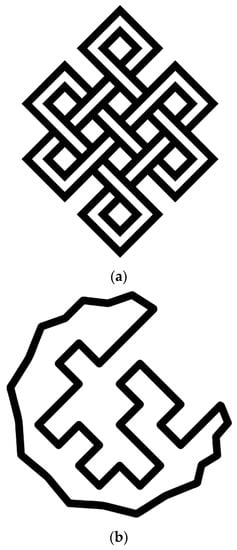
Figure 1.
(a) Tibetan endless knot pattern traced by prime condition participants. Public domain image [41]. (b) Asymmetrical pattern traced by anti-prime condition participants. This image was created by the research team.
2.2. Design
The experiment used a 3 × 2 (condition × testing time) mixed-ANCOVA design. Participants were randomly assigned to either a prime, anti-prime, or control condition, and were tested at two time points—one prior to the tracing manipulation and one following. Dependent variables included participants’ responses on the RAT, VAT, RST, and AFT.
2.3. Procedure
Participants were asked to complete the test in a lab located on the university campus. All measures were programmed using Qualtrics software and were administered using a touch-screen interface on lab computers. The experiment was broken down into three sections: (1) pre-test, (2) the demographic questionnaire and the FFMQ, and (3) post-test (see Figure 2). Participants in all conditions were randomly presented with four tests, the RAT, VAT, RST, and AFT, during the pre-test period. They were then instructed to complete the demographic questionnaire (see Document S2 in the Supplementary Materials), followed by the FFMQ. During the post-test, participants were presented with a second version of the measures from the pre-test, again in a randomized order. For the prime and anti-prime conditions, each measure in post-test was preceded by a 90 s tracing exercise of their respective images. Participants in the prime condition were asked to trace an image of a Tibetan Knot before completing the post-test dependent measures (see Figure 1a). Participants in the anti-prime condition traced an asymmetrical image that was designed by the authors (see Figure 1b). Finally, participants in the control condition did not trace any image. Participants in the prime and anti-prime condition were given detailed instructions for tracing by the lab assistant during a practice round before the post-test. Finally, participants completed a debriefing session with the lab assistant. The entire experiment took approximately one hour to complete. Our lab study script and lab study protocol checklist are provided in the Supplementary Materials (see Documents S3 and S4, respectively). Both are also available at https://dx.doi.org/10.17504/protocols.io.bnjgmcjw

Figure 2.
Visual representation of the order of measures completed in the study.
2.4. Results
2.4.1. Demographics
Participants’ mean age, gender distribution, as well as mean scores on all measures are presented in Table 1. A one-way ANOVA was conducted to determine whether significant differences existed in the demographic results between the participants in the three conditions. Participants across the three conditions did not significantly differ in regard to age, F (2, 174) = 0.64, p = 0.53 or levels of reported mindfulness, F (2, 174) = 2.23, p = 0.11.

Table 1.
Means and standard deviations of variable scores from pre-test to post-test across all three conditions. Mean values of demographic variables for all three conditions are also reported.
The analyses below test the changes in scores on each of the tested measures from pre-test to post-test across the three conditions, while controlling for participants’ levels of reported mindfulness. All analyses were conducted using the Statistical Package for Social Sciences (SPSS) program. All analyses were also conducted using a two-tailed test, with the alpha level set to p = 0.05
2.4.2. RAT Results
We conducted a 3 (condition: Prime vs. Anti-prime vs. Control) × 2 (Time: Pre-test vs. Post-test) mixed ANCOVA to assess changes in participants’ scores on the RAT, while controlling for their levels of reported mindfulness. We did not find a main effect of testing time, F (1, 169) = 3.59, p = 0.06, however this result approached the threshold for a statistically significant result, and participants across all three conditions provided more correct responses at Time 2 compared to Time 1, as illustrated in Figure 3. There was no significant main effect of condition, F (2, 169) = 0.54, p = 0.59, nor was there a significant interaction between time and condition, F (2, 169) = 0.62, p = 0.54.
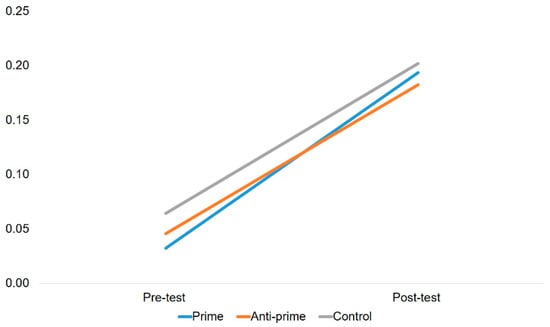
Figure 3.
Changes in participants’ mean Remote Associates Test (RAT) scores from pre- to post-test, controlling for levels of reported mindfulness.
Furthermore, we did not find a significant main effect for participants’ levels of reported mindfulness, F (1, 169) = 0.04, p = 0.84, nor did we find a significant interaction between time and reported mindfulness, F (1, 169) = 0.01, p = 0.92.
2.4.3. VAT Results
We conducted a 3 (condition: prime vs. anti-prime vs. control) × 2 (time: pre-test vs. post-test) mixed ANCOVA to assess changes in participants’ scores on the VAT, while controlling for their levels of reported mindfulness. Figure 4 illustrates our results. We did not find a main effect of testing time, F (1, 173) = 0.11, p = 0.74, condition, F (2, 173) = 0.44, p = 0.65, or testing time by condition interaction, F (2, 173) = 0.26, p = 0.78, while controlling for participants’ levels of reported mindfulness. Furthermore, we did not find a significant main effect for participants’ levels of reported mindfulness, F (1, 173) = 0.01, p = 0.94, nor did we find a significant interaction between time and reported mindfulness, F (1, 173) = 0.42, p = 0.52.
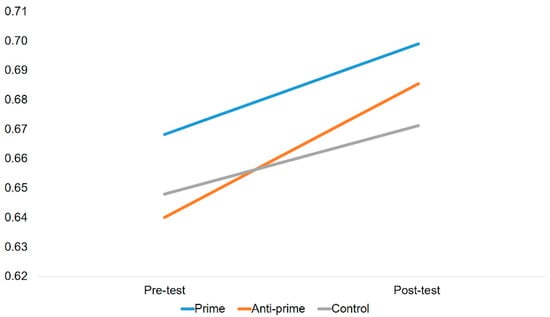
Figure 4.
Changes in participants’ mean Verbal Analogies Test (VAT) scores from pre- to post-test, controlling for levels of reported mindfulness.
2.4.4. RST Results
We conducted a 3 (condition: prime vs. anti-prime vs. control) × 2 (time: pre-test vs. post-test) mixed ANCOVA to assess changes in participants’ scores on the RST, while controlling for their levels of reported mindfulness. Figure 5 illustrates our results. We did not find a main effect of testing time, F (1, 173) = 0.43, p = 0.52, condition, F (2, 173) = 1.03, p = 0.36, or testing time by condition interaction, F (2, 173) = 1.11, p = 0.33, while controlling for participants’ levels of reported mindfulness. Furthermore, we did not find a significant main effect for participants’ levels of reported mindfulness, F (1, 173) = 0.93, p = 0.34, nor did we find a significant interaction between time and reported mindfulness, F (1, 173) = 0.02, p = 0.89.
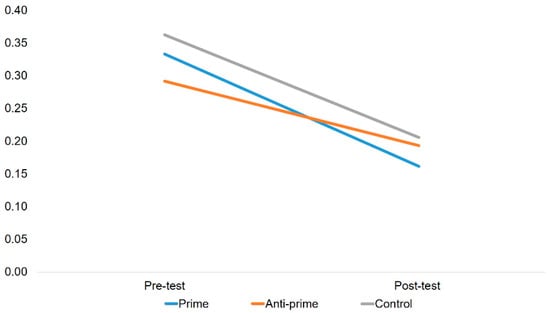
Figure 5.
Changes in participants’ mean Reciprocal Syntax Test (RST) scores from pre- to post-test, controlling for levels of reported mindfulness.
2.4.5. AFT Results
We conducted a 3 (condition: prime vs. anti-prime vs. control) × 2 (time: pre-test vs. post-test) mixed ANCOVA to assess changes in participants’ scores for both the total semantic distance of valid analogies, as well as the cross-domain semantic distance of valid analogies, while controlling for their levels of reported mindfulness. Both sets of scores were derived from participants’ responses on the AFT (see Methods section). For participants’ scores of the total semantic distance of valid analogies, we did not find a significant main effect of time, F (1, 172) = 1.14, p = 0.29, condition, F (2, 172) = 1.01, p = 0.37, or time by condition interaction, F (1, 172) = 0.31, p = 0.73, when controlling for their levels of reported mindfulness. Furthermore, we did not find a significant main effect for participants’ levels of reported mindfulness, F (1, 172) = 1.38, p = 0.24, nor did we find a significant interaction between time and reported mindfulness, F (1, 172) = 1.74, p = 0.19.
For participants’ scores of the cross-domain semantic distance of valid analogies, we did not find a significant main effect of time, F (1, 172) = 1.15, p = 0.29, condition, F (2, 172) = 0.75, p = 0.47, or time by condition interaction, F (1, 172) = 1.21, p = 0.30, when controlling for their levels of reported mindfulness. Furthermore, we did not find a significant main effect for participants’ levels of reported mindfulness, F (1, 172) = 1.36, p = 0.25, nor did we find a significant interaction between time and reported mindfulness, F (1, 172) = 1.46, p = 0.23.
3. Study 2
Following the completion of Study 1, we opted to run a second, scaled-down version of the study in order to address two questions generated during Study 1. First, we observed that the results of the AFT measure patterned in ways that were qualitatively divergent from the results of other studies (see Figure 6a,b). Second, during exit interviews following Study 1, some participants independently reported fatigue with 90 s tracing exercises. In order to determine whether or not the unusual results were simply anomalous, and in order to rule out the possibility of skewing due to fatigue distraction, we undertook a second round of cognitive trials. Tracing time for prime and anti-prime condition participants in Study 2 was shortened by 30 s for a total tracing time of one minute. This timeframe represents the lower threshold of the 60–90 s interval recommended by numerous studies on mindfulness training and self-control [36,37,40]. Pre- and post-test measures were restricted to AFT only.

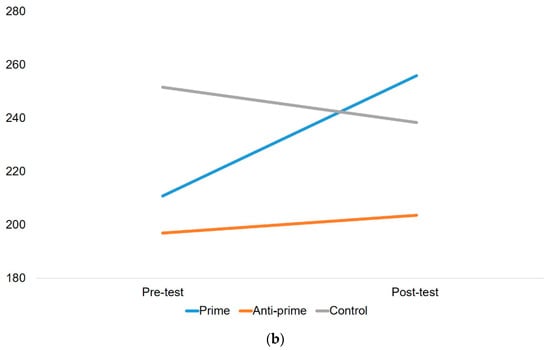
Figure 6.
(a) Changes in participants’ mean AST total semantic distance (TSD) scores from pre- to post-test, controlling for levels of reported mindfulness. (b) Changes in participants’ mean Analogy Finding Task (AFT) cross-domain semantic distance (CDSD) scores from pre- to post-test, controlling for levels of reported mindfulness.
3.1. Materials and Methods
3.1.1. Participants
Overall, 190 Ryerson Undergraduate students were recruited from 3 classes offered at the university during the fall 2018 and winter 2019 semesters. Participation in the study or the completion of an alternative assignment accounted for 5% of the class grade. Of the 190 participants, 27 were excluded for not following tracing instructions (including instances of skipping one or more round of tracing and/or continuing to trace instead of advancing to the next measure as instructed), 1 for familiarity with the materials, 1 for having previously participated in Study 1, 6 for self-reported reasons (including not paying attention or deliberately not following instructions), and 2 for other reasons (including one early departure prior to completion and one who insisted on tracing the pattern a different way each time, contrary to instructions). This left a total of 153 participants. Of this number, 111 students identified as female (72.5%), 40 (26.1%) identified as male, and 2 (1.3%) identified as other. Participants were between the ages of 17–28 (M: 19.66, SD: 2.40). Students were randomly assigned to conditions using the same online randomizer tool as in Study 1 (50 = prime, 50 = anti-prime, 53 = control).
3.1.2. Materials
Study 2 included the AFT, the demographics questionnaire, the FFMQ, and the tracing applications from Study 1.
3.2. Design
Similar to Study 1, Study 2 used a 3 × 2 (condition × testing time) mixed-ANCOVA design. Participants were randomly assigned to either a prime, anti-prime, or control condition, and were tested at two time points—one prior to the tracing manipulation and one following. The dependent variable was participants’ responses on the AFT only.
3.3. Procedure
The procedure for Study 2 mirrored that of Study 1. However, in Study 2, the pre- and post-test included the AFT measure only. For the prime and anti-prime conditions, the AFT measure in the post-test was preceded by a 60 s tracing exercise of the respective condition images (Figure 1a,b). Identical to Study 1, participants in the prime condition were asked to trace an image of a Tibetan Knot (Figure 1a) prior to completing the AFT. Participants in the anti-prime condition traced the same asymmetrical image that was used in Study 1. Finally, participants in the Control condition did not trace any image. The entire experiment took approximately 30 min to complete.
In addition to instructions provided in Study 1, the following instructions were added:
“Please think creatively as you search for valid analogies. Some analogies may not be obvious right away, so be sure to look for abstract connections. However, only valid analogies should be listed, so don’t list analogies unless you can describe how the two word pairs are analogous.” This wording was added to the original instructions to emphasize to participants that they should not only be creative, but also choose only analogies that they could explain so as to avoid “false-alarm” responses.
3.4. Results
3.4.1. Demographics
Similar to Study 1, participants’ mean age, gender distribution, as well as mean scores on all measures were collected (see Table 2). Participants in the three conditions did not significantly differ in regard to age, F(2, 148) = 0.27, p = 0.77, or levels of reported mindfulness, F(2, 150) = 0.43, p = 0.65.

Table 2.
Means and standard deviations of participants’ AFT scores for Study 2 from pre-test to post-test across all three conditions. Mean values of demographic variables for all three conditions were also reported.
3.4.2. AFT Results
We conducted a 3 (condition: prime vs. anti-prime vs. control) × 2 (time: pre-test vs. post-test) mixed ANCOVA to assess changes in participants’ scores for both the total semantic distance of valid analogies, as well as the cross-domain semantic distance of valid analogies, while controlling for their levels of reported mindfulness (see Figure 7a,b). Both sets of scores were derived from participants’ responses on the AFT (see Methods section). For participants’ scores of the total semantic distance of valid analogies, we did not find a significant main effect of time, F (1, 149) = 0.03, p = 0.86, condition, F (2, 149) = 0.20, p = 0.82, or time by condition interaction, F (1, 149) = 0.48, p = 0.62, when controlling for their levels of reported mindfulness. Furthermore, we did not find a significant main effect for participants’ levels of reported mindfulness, F (1, 149) = 0.18, p = 0.67, nor did we find a significant interaction between time and reported mindfulness, F (1, 149) = 0.13, p = 0.72.
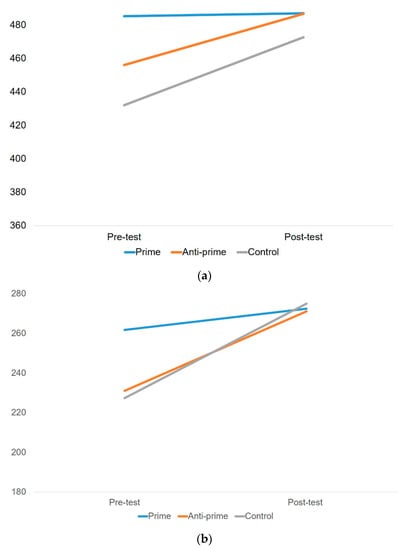
Figure 7.
(a) Study 2 changes in participants’ mean AST TSD scores from pre- to post-test, controlling for levels of reported mindfulness. (b) Study 2 changes in participants’ mean AFT CDSD scores from pre- to post-test, controlling for levels of reported mindfulness.
For participants’ scores of the cross-domain semantic distance of valid analogies, we did not find a significant main effect of time, F (1, 149) = 0.06, p = 0.81, condition, F (2, 149) = 0.07, p = 0.93, or time by condition interaction, F (2, 149) = 0.51, p = 0.60, when controlling for their levels of reported mindfulness. Furthermore, we did not find a significant main effect for participants’ levels of reported mindfulness, F (1, 149) = 0.24, p = 0.63, nor did we find a significant interaction between time and reported mindfulness, F (1, 149) = 0.26, p = 0.61.
4. Discussion
Whether or not the qualitatively anomalous results observed in the Study 1 AFT findings were due to fatigue distraction, same scale comparisons of AFT scores in Figure 8 and Figure 9 reveal that the Study 2 AFT results pattern more closely to the results of other measures in Study 1, with observable main effects of time but not of condition, and with no significant main effects of either time or condition. Our core data sets for both studies are available on Zenodo [42].
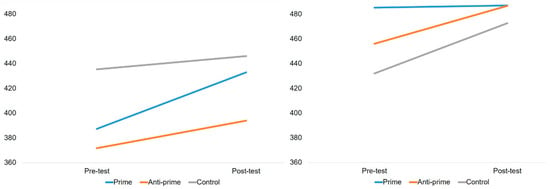
Figure 8.
Same scale comparison of AFT TSD between Study 1 (left) and Study 2 (right).
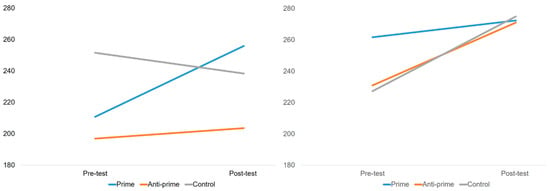
Figure 9.
Same scale comparison of AFT CDSD between Study 1 (left) and Study 2 (right).
Contrary to our primary hypotheses, these two studies reveal no correlation between basic measures of analogical pattern solving, creative cognition and mindful tracing of a ritual knot design. Something most of our tests share in common is a focus on analytic or deductive analogical reasoning processes. Although this was one of the parameters of the experiment, this fairly formal mode of analogy is far from the sum of analogic cognition [17,22]. As a result, this research is only a beginning: opening the way for further exploration of potential cognitive affordances and cognitive alignments shared with ritual knots. Many other perspectives and approaches should also be considered.
Modes of creative cognition that are more complex and less formal may still be related to cultural patterns of visual symmetry and should be tested. Another limitation of the study presented here is its focus on the short-term effects of tracing symmetrical knot designs. More complex, longer-term effects should also be considered. Ritualized contexts in which symmetries are salient may hold further clues [43], as may symmetry preferences in visual perception [44,45,46]. As research on symmetry processing has demonstrated at both ontogenetic and phylogenetic levels of development, the human visual system is more adept in the perception of symmetry than the human manual system is in the production of symmetry [47,48]. Since it is possible that ritual knot symmetries are more directly aligned with the visual modality than the manual, visual adaptations of this experiment (and others to come) should be tested as well.
In conclusion, in spite of the null results from our initial experiments, we successfully accomplished our aim of opening up the empirical study of symmetrical knot designs from a cognitive semiotic perspective. We accomplished this first by hypothesizing that the manual reproduction of a specific symmetrical knot design would have a positive influence on the performance on tasks related to formal modes of creative analogic cognition, especially to the degree that the pattern in question was traced mindfully. This hypothesis was based on the observation of patterned congruencies shared between symmetrical knot designs and descriptions of creative analogy in the literature. We then designed a series of cognitive trials testing for potential benefits of manually tracing a basic, traditional knot design from Tibet. We selected three established measures of formal analogical reasoning and one original measure of syntactic preference involving reciprocal constructions and contrasted prime condition results with a control group and an anti-prime condition group. Our results show observable effects of time across multiple measures, but no significant effects of time or condition, controlling for reported mindfulness. While this rules out the priming effects of enhanced analogical reasoning at the analytic level following brief manual tracing of the selected design, many other possibilities remain to be tested. As such, the research opens the way for further empirical experimentation on the nature and emergence of symmetrical knots and the relationships they potentially share with patterns of human thought.
Supplementary Materials
The following are available online at https://www.mdpi.com/2073-8994/13/1/34/s1, Document S1: Reciprocal Syntax Test (RST), Document S2: Demographic Questionnaire, Document S3: Lab Study Script, Document S4: Lab Study Checklist.
Author Contributions
Conceptualization, J.P., Z.V. and S.W.M.; methodology, J.P., Z.V. and S.P.; software, J.P. and S.P.; validation, Z.V. and J.P.; formal analysis, Z.V.; investigation, S.P. and J.P.; resources, J.P.; data curation, S.P.; writing—original draft preparation, J.P., Z.V., S.P. and S.W.M.; writing—review and editing, J.P.; visualization, Z.V., J.P. and S.P.; supervision, J.P.; project administration, J.P.; funding acquisition, J.P. and S.W.M. All authors have read and agreed to the published version of the manuscript.
Funding
This research was funded by the Social Sciences and Humanities Research Council of Canada <www.sshrc-crsh.gc.ca> (SSHRC-IDG #430-2015-01226) to J. Pelkey (PI) and S. Walsh Matthews (collaborator), and by the Ryerson University Undergraduate Research Opportunity (URO) program, to J. Pelkey and S. Park, from the Office of the Vice President for Research and Innovation, Ryerson University <www.ryerson.ca/research/>.
Institutional Review Board Statement
The studies reported here were conducted according to the guidelines of the Declaration of Helsinki, and approved by the Research Ethics Board of Ryerson University (REB 2017-065, 31 August 2017).
Informed Consent Statement
All participants provided written consent prior to participation.
Data Availability Statement
Core data sets for Study 1 and Study 2 are openly available in Zenodo at doi:10.5281/zenodo.3635095.
Acknowledgments
We gratefully acknowledge the support of Rami Matloob, who designed the prototype app for onscreen tracing of the Tibetan knot design. Shahnawaz Syed and Mathew Iantorno provided further support in modifying the app for ease of use, including the integration of the app with the Qualtrics interface. While the majority of lab testing was directly administered by the third author S.P., we gratefully acknowledge the support of Michael Lisinski, Jade Hines, Nikita Sankreacha, Irene Storozhuk, Rebecca Abrams, and Caitlin Sivell as lab members who assisted S.P. with administering the study at various stages. Finally, we are thankful for the insightful comments received during the peer review process for this article.
Conflicts of Interest
The authors declare no conflict of interest. The funders had no role in the design of the study; in the collection, analyses, or interpretation of data; in the writing of the manuscript, or in the decision to publish the results.
References
- Bloch, M. Anthropology and the Cognitive Challenge; Cambridge University Press: Cambridge, UK, 2012. [Google Scholar]
- Pelkey, J. Symmetrical reasoning in language and culture: On ritual knots and embodied cognition. In Meaning, Mind and Communication; Zlatev, J., Sonesson, G., Konderak, P., Eds.; Peter Lang: Bern, Switzerland, 2016; pp. 239–249. [Google Scholar]
- Tylén, K.; Fusaroli, R.; Rojo, S.; Heimann, K.; Fay, N.; Johannsen, N.N.; Riede, F.; Lombard, M. The evolution of early symbolic behavior in Homo sapiens. Proc. Natl. Acad. Sci. USA 2020, 117, 4578–4584. [Google Scholar] [CrossRef] [PubMed]
- Lewis-Williams, J.D.; Dowson, T.A.; Bahn, P.G.; Bandi, H.-G.; Bednarik, R.G.; Clegg, J.; Consens, M.; Davis, W.; Delluc, B.; Delluc, G. The signs of all times: Entoptic phenomena in upper Paleolithic art. Curr. Anthropol. 1988, 29, 201–245. [Google Scholar] [CrossRef]
- Klüver, H. Mescal and Mechanisms of Hallucinations; University of Chicago Press: Chicago, IL, USA, 1966. [Google Scholar]
- Froese, T. Altered states and the prehistoric ritualization of the modern human mind. In Breaking Convention: Essays on Psychedelic Consciousness; Adams, C., Waldstein, A., Luke, D.P., Sessa, B., King, D., Eds.; Strange Attractor Press: London, UK, 2013; pp. 10–21. [Google Scholar]
- Froese, T.; Woodward, A.; Ikegami, T. Turing instabilities in biology, culture, and consciousness? On the enactive origins of symbolic material culture. Adapt. Behav. 2013, 21, 199–214. [Google Scholar] [CrossRef]
- Pelkey, J. The Semiotics of X: Chiasmus, Cognition and Extreme Body Memory; Bloomsbury Academic: London, UK, 2017. [Google Scholar]
- Henshilwood, C.S.; D’Errico, F.; Yates, R.; Jacobs, Z.; Tribolo, C.; Duller, G.A.T.; Mercier, N.; Sealy, J.C.; Valladas, H.; Watts, I.; et al. Emergence of modern human behavior: Middle Stone Age engravings from South Africa. Science 2002, 295, 1278–1280. [Google Scholar] [CrossRef] [PubMed]
- Henshilwood, C.S.; D’Errico, F.; Watts, I. Engraved ochres from the middle stone age levels at Blombos Cave, South Africa. J. Hum. Evol. 2009, 57, 27–47. [Google Scholar] [CrossRef]
- Rio, K. Discussions around a sand-drawing: Creations of agency and society in Melanesia. J. R. Anthr. Inst. 2005, 11, 410–423. [Google Scholar] [CrossRef]
- Küchler, S. Imaging the Body Politic. The Knot in Pacific Imagination. Homme Rev. Française Anthropol. 2003, 165, 205–222. [Google Scholar]
- Ogawa, A.; Yamazaki, Y.; Ueno, K.; Cheng, K.; Iriki, A. Neural correlates of species-typical illogical cognitive bias in human inference. J. Cogn. Neurosci. 2009, 22, 2120–2130. [Google Scholar] [CrossRef]
- Hattori, M.; Yamazaki, Y. Symmetry and bidirectionality in cognitive science: Introduction to the feature “Symmetry: The search for the foundation of thinking, language, and communication”. Cogn. Stud. Bull. Jpn. Cogn. Sci. Soc 2008, 15, 315–321. [Google Scholar] [CrossRef]
- Imai, M.; Okada, H. Commentary: Is the symmetry inference the chicken or the egg for language learning? Cogn. Stud. Bull. Jpn. Cogn. Sci. Soc. 2008, 15, 470–481. [Google Scholar] [CrossRef]
- Imai, M. The “symbol grounding” problem reinterpreted from the perspective of language acquisition. In Meaning, Mind and Communication; Zlatev, J., Sonesson, G., Konderak, P., Eds.; Peter Lang: Bern, Switzerland, 2016; pp. 145–159. [Google Scholar]
- Hofstadter, D.; Sander, E. Surfaces and Essences: Analogy as the Fuel and Fire of Thinking; Basic Books: New York, NY, USA, 2013. [Google Scholar]
- Merleau-Ponty, M. The intertwining—The chiasm. In Le Visible et L’invisible: The Visible and the Invisible; Lefort, C., Ed.; Lingis, A., Translator; Northwestern University Press: Evanston, IL, USA, 1968; pp. 130–155. [Google Scholar]
- Wiseman, B.; Paul, A. (Eds.) Chiasmus and Culture; Berghahn Books: Oxford, UK, 2014. [Google Scholar]
- Pelkey, J. Symbiotic modeling: Linguistic anthropology and the promise of chiasmus. Rev. Anthropol. 2016, 45, 22–50. [Google Scholar] [CrossRef]
- Tomlinson, M. Ritual Textuality: Pattern and Motion in Performance; Oxford University Press: Oxford, UK, 2014. [Google Scholar]
- Fauconnier, G.; Turner, M. The Way We Think: Conceptual Blending and the Mind’s Hidden Complexities; Basic Books: New York, NY, USA, 2002. [Google Scholar]
- Turner, M. The Origin of Ideas: Blending, Creativity, and the Human Spark; Oxford University Press: Oxford, UK, 2014. [Google Scholar]
- Weng, J.; Zhang, H. Pseudohaptic interaction with knot diagrams. J. Electron. Imaging 2012, 21, 033008. [Google Scholar] [CrossRef]
- Jung, C.G. Mandalas. In The Archetypes and the Collective Unconscious, 2nd ed.; Princeton University Press: Princeton, NJ, USA, 1955; pp. 385–390. [Google Scholar]
- Ireland, M.S.; Brekke, J. The mandala in group psychotherapy: Personal identity and intimacy. Arts Psychother. 1980, 7, 217–231. [Google Scholar] [CrossRef]
- Curry, N.; Kasser, T. Can coloring mandalas reduce anxiety? Art Ther. 2005, 22, 81–85. [Google Scholar] [CrossRef]
- Henderson, P.; Rosen, D.; Mascaro, N. Empirical study on the healing nature of mandalas. Psychol. Aesthet. Creat. Arts 2007, 1, 148–154. [Google Scholar] [CrossRef]
- Pisarik, C.T.; Larson, K.R. Facilitating college students’ authenticity and psychological well-being through the use of Mandalas: An empirical study. J. Humanist. Couns. 2011, 50, 84. [Google Scholar] [CrossRef]
- Van der Vennet, R.; Serice, S. Can coloring mandalas reduce anxiety? A replication study. Art Ther. 2012, 29, 87–92. [Google Scholar] [CrossRef]
- Mednick, S. The associative basis of the creative process. Psychol. Rev. 1962, 69, 220–232. [Google Scholar] [CrossRef]
- Carriedo, N.; Corral, A.; Montoro, P.R.; Herrero, L.; Ballestrino, P.; Sebastián, I. The development of metaphor comprehension and its relationship with relational verbal reasoning and executive function. PLoS ONE 2016, 11, e0150289. [Google Scholar] [CrossRef]
- Weinberger, A.B.; Iyer, H.; Green, A.E. Conscious augmentation of creative state enhances “real” creativity in open-ended analogical reasoning. PLoS ONE 2016, 11, e0150773. [Google Scholar] [CrossRef]
- Green, A.E.; Spiegel, K.A.; Giangrande, E.J.; Weinberger, A.B.; Gallagher, N.M.; Turkeltaub, P.E. Thinking cap plus thinking zap: tDCS of frontopolar cortex improves creative analogical reasoning and facilitates conscious augmentation of state creativity in verb generation. Cereb. Cortex 2016, 27, 2628–2639. [Google Scholar] [CrossRef] [PubMed]
- Baer, R.A.; Smith, G.T.; Hopkins, J.; Krietemeyer, J.; Toney, L. Using self-report assessment methods to explore facets of mindfulness. Assessment 2006, 13, 27–45. [Google Scholar] [CrossRef] [PubMed]
- Christoff, K.; Gordon, A.M.; Smallwood, J.; Smith, R.; Schooler, J.W. Experience sampling during fMRI reveals default network and executive system contributions to mind wandering. Proc. Natl. Acad. Sci. USA 2009, 106, 8719–8724. [Google Scholar] [CrossRef] [PubMed]
- Smallwood, J.; McSpadden, M.; Schooler, J.W. The lights are on but no one’s home: Meta-awareness and the decoupling of attention when the mind wanders. Psychon. Bull. Rev. 2007, 14, 527–533. [Google Scholar] [CrossRef]
- Rowland, Z.; Wenzel, M.; Kubiak, T. Effects of an ultra-brief computer-based mindfulness training on mindfulness and self-control: A randomised controlled trial using a 40-day ecological momentary assessment. Mindfulness 2019, 10, 2312–2326. [Google Scholar] [CrossRef]
- Levinson, D.B.; Stoll, E.L.; Kindy, S.D.; Merry, H.L.; Davidson, R.J. A mind you can count on: Validating breath counting as a behavioral measure of mindfulness. Front. Psychol. 2014, 5, 1202. [Google Scholar] [CrossRef]
- Crumley, G.; Schutz, H. Short-duration mindfulness training with adult learners. Adult Learn. 2011, 22, 37–42. [Google Scholar] [CrossRef]
- Wikimedia Commons. File: EndlessKnot3d.svg. Available online: https://commons.wikimedia.org/w/index.php?title=File:EndlessKnot3d.svg&oldid=182708356 (accessed on 30 September 2019).
- Vahedi, Z.; Park, S.; Pelkey, J.; Walsh Matthews, S. Testing ritual knot tracing for cognitive priming effects rules out analytic analogy: Core data sets. Zenodo 2019. [Google Scholar] [CrossRef]
- Boyer, P.; Liénard, P. Why ritualized behavior? Precaution systems and action parsing in developmental, pathological and cultural rituals. Behav. Brain Sci. 2006, 29, 595–613. [Google Scholar] [CrossRef]
- Bornstein, M.H.; Ferdinandsen, K.; Gross, C.G. Perception of symmetry in infancy. Dev. Psychol. 1981, 17, 82–86. [Google Scholar] [CrossRef]
- Humphrey, D. Preferences in symmetries and symmetries in drawings: Asymmetries between ages and sexes. Empir. Stud. Arts 1997, 15, 41–60. [Google Scholar] [CrossRef]
- Makin, A.D.J.; Pecchinenda, A.; Bertamini, M. Implicit affective evaluation of visual symmetry. Emotion 2012, 12, 1021–1030. [Google Scholar] [CrossRef] [PubMed]
- Humphrey, D. Symmetries in development: The eye is quicker than the hand. In Embedded Symmetries: Natural and Cultural; Washburn, D.K., Ed.; University of New Mexico Press: Albuquerque, NM, USA, 2004; pp. 7–17. [Google Scholar]
- Hodgson, D. The first appearance of symmetry in the human lineage: Where perception meets art. Symmetry 2011, 3, 37–53. [Google Scholar] [CrossRef]
Publisher’s Note: MDPI stays neutral with regard to jurisdictional claims in published maps and institutional affiliations. |
© 2020 by the authors. Licensee MDPI, Basel, Switzerland. This article is an open access article distributed under the terms and conditions of the Creative Commons Attribution (CC BY) license (http://creativecommons.org/licenses/by/4.0/).